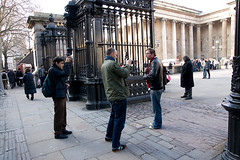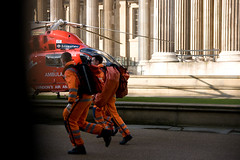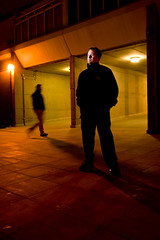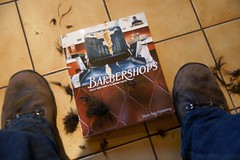Update:The date of Richard's Private viewing has changed to the 26th March not the 23rd as previously reported
 I appear to have posted the last article prematurely as is was supposed to follow on from this one. So this post might make the previous one make more sense...
I appear to have posted the last article prematurely as is was supposed to follow on from this one. So this post might make the previous one make more sense...
I was wandering about one lunchtime when I heard the sound of a helicopter landing. So I rushed over to the British Museum where the
air ambulance had landed, just in time to take a quick snapshot through the railings of the paramedics rushing to the scene of the accident. I hung around taking photos of the helicopter for a while, and then spotted a photographer and his assitant, photographing Danny Wallace. When it looked like he was finished up I wandered over and introduced myself.
The photographer was
Richard Ansett, an award winning photographer, whose work has graced the Tate Modern and the National Portrait Gallery. Though Richard hadn't heard of the
strobist, his kit is almost strobist in style. He was using a
Norman flashhead with a 5 inch reflector triggered with a pocket wizard. He told me they were great little flashes that made it look like you had been working all day. When I told him that I was admiring his voice activated lightstand, he informed me that he sells them, he imports them cheap from abroad. I'm not sure whether to believe him. There is certainly no price list on his website. Perhaps he sells them under the counter?
If you have a look at his portfolio you will see quite a few examples where he uses a simple one light setup to drop the ambient light and create moody images. On some of his indoor shots you will see a heavy yet soft edged shadow that works nicely as a graphic element. Nice.
Go take a look
I contacted Richard by email and this is what he had to say.
I've been using Normans since I started and I was trained on them originally by photographers working on film and I had to guess the exposures without a lightmeter..great training..they still are the most portable of light sources and combined with the pocket wizard are incredibly versatile when attached to an assistant; the shoot and lighting can evolve through a shoot very quickly as you don't have to keep stopping to move the stand.
the flash duration is incredibly fast so any moving or jumping works very successfully. The only problems with Normans are that they ar not 100% reliable, lots of little things can go wrong with them , which is managable on an editorial shoot but advertising demands more consistency and i use prophoto 7b's on location..
you did well to notice the soft edged shadow..this s very important to me..I use an improvised baby soft box so the light spread is minimal and it gives the work a painterly feel I think..the best way to show the quality of the soft box is in the transition from the lit area into the shadow..
One light is preferred and if I use more I try and disguise the fact that I am 'over' lighting..it sounds easy but lighting correctly with one light source off camera is a real creative challenge and it is very easy to get the mood wrong.. feather lighting is the key with a small soft box (changing the angle on the subject).. the smallest movements can affect the mood of a picture completely so a human light stand it great for this.
I have travelled extensively with the normans and they have give me amazing results that conceal the small amount of time I am with some subjects, working quickly and therefore understanding all the technical elements, gives me my best and most spontaneous performances; and even on a bare head with reflector the light source is not un- flattering..

Richard has a solo show at a contemporary art space - Tenderpixel from 24th March, Private View is the 26th March and Richard has kindly offered to let my readers come along. If you would like to go to the private viewing please drop me an
email and I will let you know what you need to do to get in.
TENDERPIXEL GALLERY
10, Cecil Court, London WC2N 4HE
P: 02073799464
 I was asked to take some corporate headshots in the office for my Company's website. The challenge was that nobody would be able to spend more than a few minutes getting their picture taken and not everyone would be available on the same day. So taking a leaf out of Kirk Tuck's book; after setting up the lighting to my satisfaction, I made a diagram, wrote down all the flash and camera settings and took a couple of photos of the setup.
I was asked to take some corporate headshots in the office for my Company's website. The challenge was that nobody would be able to spend more than a few minutes getting their picture taken and not everyone would be available on the same day. So taking a leaf out of Kirk Tuck's book; after setting up the lighting to my satisfaction, I made a diagram, wrote down all the flash and camera settings and took a couple of photos of the setup.  It was a pretty simple two light setup. I used one light on the background and another light camera right through a half-silver shoot-through umbrella. In order to get a bit of fill on the left hand side I brought over a a flip chart and placed it on the opposite side to the umbrella. The half-silvered umbrella was interesting. The shadows are a bit harsher than I'm used to with the white shoot through umbrella, which is why I used the white board, but the result isn't unpleasant. But I will probably be using the white ones when my new ones are delivered.
It was a pretty simple two light setup. I used one light on the background and another light camera right through a half-silver shoot-through umbrella. In order to get a bit of fill on the left hand side I brought over a a flip chart and placed it on the opposite side to the umbrella. The half-silvered umbrella was interesting. The shadows are a bit harsher than I'm used to with the white shoot through umbrella, which is why I used the white board, but the result isn't unpleasant. But I will probably be using the white ones when my new ones are delivered.








